Synology DS2015xs Review: An ARM-based 10G NAS
by Ganesh T S on February 27, 2015 8:20 AM EST- Posted in
- NAS
- Storage
- Arm
- 10G Ethernet
- Synology
- Enterprise
Direct-Attached Storage Performance
The presence of 10G ports on the Synology DS2015xs presents some interesting use-cases. As an example, video production houses have a need for high-speed storage. Usually, direct-attached storage units suffice. Thunderbolt is popular for this purpose - for both single-user modes as well as part of a SAN. However, as 10G network interfaces become common and affordable, there is scope for NAS units to act as a direct-attached storage units also. In order to evaluate the DAS performance of the Synology DS2015xs, we utilized the DAS testbed augmented with an appropriate CNA (converged network adapter), as described in the previous section. To get an idea of the available performance for different workloads, we ran a couple of quick artificial benchmarks along with a subset of our DAS test suite.
CIFS
In the first case, we evaluate the performance of a CIFS share created in a RAID 5 volume. One of the aspects to note is that the direct link between the NAS and the testbed is configured with a MTU of 9000 (compared to the default of 1500 used for the NAS benchmarks).
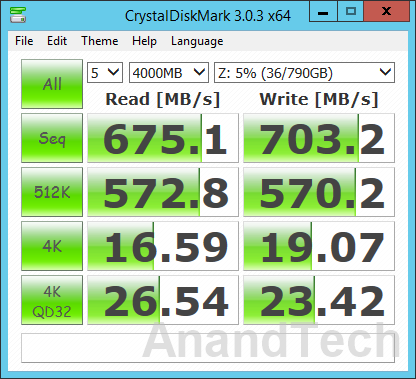
Our first artificial benchmark is CrystalDiskMark, which tackles sequential accesses as well as 512 KB and 4KB random accesses. For 4K accesses, we have a repetition of the benchmark at a queue depth of 32. As the screenshot above shows, Synology DS2015xs manages around 675 MBps reads and 703 MBps writes. The write benchmark number corresponds correctly to the claims made by Synology in their marketing material, but the 675 MBps read speeds are a far cry from the promised 1930 MBps. We moved on to ATTO, another artificial benchmark, to check if the results were any different.
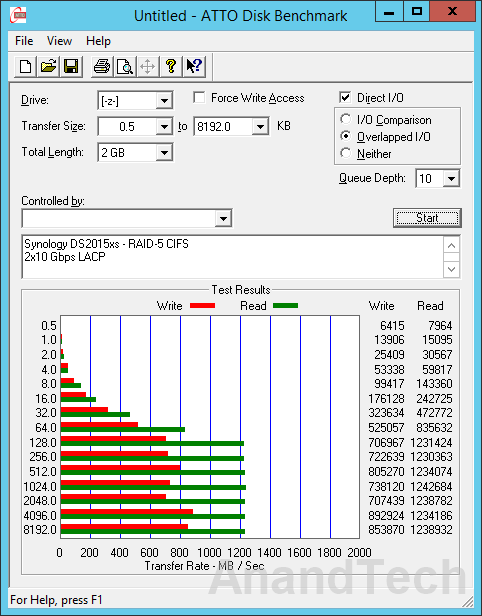
ATTO Disk Benchmark tackles sequential accesses with different block sizes. We configured a queue depth of 10 and a master file size of 4 GB for accesses with block sizes ranging from 512 bytes to 8 MB and the results are presented above. In this benchmark, we do see 1 MB block sizes giving read speeds of around 1214 MBps.
| Synology DS2015xs - 2x10 Gbps LACP - RAID-5 CIFS DAS Performance (MBps) | ||
| Read | Write | |
| Photos | 594.69 | 363.47 |
| Videos | 915.95 | 500.09 |
| Blu-ray Folder | 949.32 | 543.93 |
For real-world performance evaluation, we wrote and read back multi-gigabyte folders of photos, videos and Blu-ray files. The results are presented in the table below. These numbers show that it is possible to achieve speeds close to 1 GBps for real-life workloads. The advantage of a unit like the DS2015xs is that the 10G interfaces can be used as a DAS interface, while the other two 1G ports can connect the unit to the rest of the network for sharing the contents seamlessly with other computers.
iSCSI
We configured a block-level (Single LUN on RAID) iSCSI LUN in RAID-5 using all available disks. Network settings were retained from the previous evaluation environment. The same benchmarks were repeated in this configuration also.
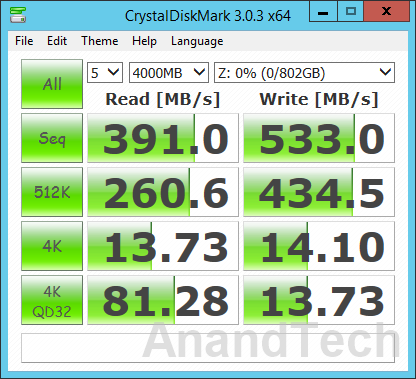
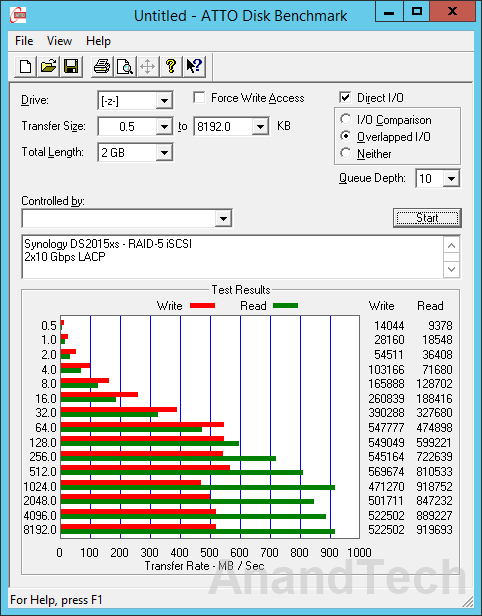
The iSCSI performance seems to be a bit off compared to what we got with CIFS. Results from the real-world performance evaluation suite are presented in the table below. These numbers track what we observed in the artificial benchmarks too.
| Synology DS2015xs - 2x10 Gbps LACP - RAID-5 iSCSI DAS Performance (MBps) | ||
| Read | Write | |
| Photos | 535.28 | 532.54 |
| Videos | 770.41 | 483.97 |
| Blu-ray Folder | 734.51 | 505.3 |
Performance Analysis
The performance numbers that we obtained with teamed ports (20 Gbps) were frankly underwhelming. The more worrisome aspect was that we couldn't replicate Synology's claims of upwards of 1900 MBps throughput for reads. In order to determine if there were any issues with our particular setup, we wanted to isolate the problem to either the disk subsystem on the NAS side or the network configuration. Unfortunately, Synology doesn't provide any tools to evaluate them separately. For optimal functioning, 10G links require careful configuration on either side.
iPerf is the tool of choice for many when it comes to ensuring that the network segment is operating optimally. Unfortunately, iPerf for DSM requires an optware package that is not yet available for the Alpine platform. On the positive side, Synology had uploaded the tool chain for Alpine on SourceForge - this helped us to cross-compile iPerf from source for the DS2015xs. Armed with iPerf on both the NAS and the testbed side, we proceeded to evaluate the links operating simultaneously without the teaming overhead.
The screenshot above shows that the two links together saturated at around 5 Gbps (out of the theoretically possible 20 Gbps), but the culprit was our cross-compiled iPerf executable (with each instance completely saturating one core - 25% of the CPU).
In the CIFS case, the smbd process is not multi-threaded, and this severely affects the utilization of the 10G links fully.
In the iSCSI case, the iscsi_trx process also seems to saturate one CPU core, leading to similar results for 10G link utilization.
On the whole, the 10G links are getting utilized, but not to the full possible extent. The utilization is definitely more than, say, four single GbE links teamed together, but the presence of two 10G links had us expecting more from the unit as a DAS.


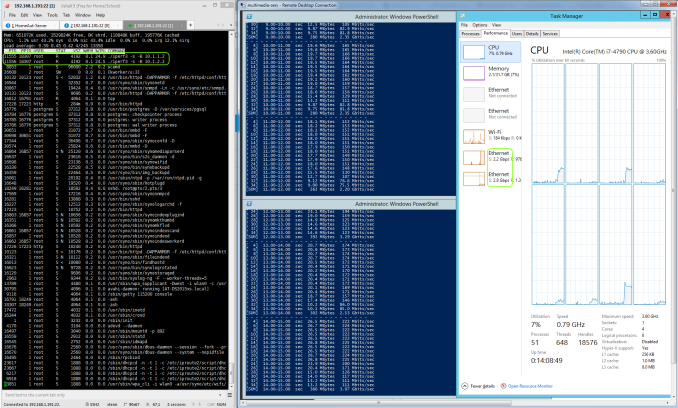
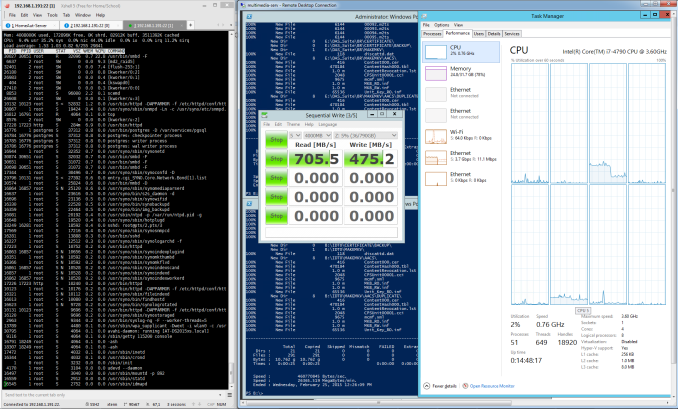
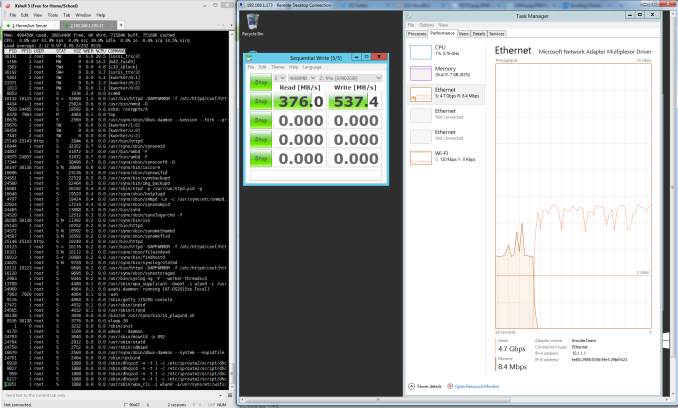








49 Comments
View All Comments
M4stakilla - Monday, March 2, 2015 - link
I currently have a 1TB M550 and 6x 4TB desktop HDDs (will expand to 8x) in RAID5 + an offline backup (5x 4TB)So nothing exceeds 500MB/sec and no real upgrade plans for that either
but it would be a a shame to waste 400MB/sec of the 500MB/sec on stupid network limitations
4x 1Gbit teamed might be worth a look though, thanks
usernametaken76 - Friday, February 27, 2015 - link
Yes, a Mac Mini with Thunderbolt and, just one example, a LaCie 5big Thunderbolt (in sizes from 10 to 30 TB) does offer exactly this, almost times 2. The Thunderbolt 2 models, even more. These are geared more towards video editing but provides every bit of the bandwidth you crave.M4stakilla - Sunday, March 1, 2015 - link
Thanks for the advice!Looking further into Thunderbolt... Cabling seems quite expensive though : 300+ euro for 10m, 500+ euro for 20m :(
Out of ethical reasons, I'm trying to avoid Apple at all costs, so no Mac Mini for me...
Also the LaCie 5big is a bit silly, as I already have the HDDs and the LaCie is including HDDs.
usernametaken76 - Tuesday, March 3, 2015 - link
You can get four drive empty Thunderbolt cases from OWC. And of course a PC motherboard with Thunderbolt are available via add-in card, Asus makes a good Z97 board for about $400 with everything but the kitchen sink. Not sure why you're seeing such high prices for a 10m cable. They shouldn't be more than $50 for a 6m cable. They were working on optical cable extensions to the original copper cabling (with Mini-DP headers)..perhaps that's what you're seeing?usernametaken76 - Tuesday, March 3, 2015 - link
Make that $39 for a 2m cable. I believe you are looking at active optical cables that you wouldn't need unless you have to have a very long run for some reason. Is there a reason the storage has to be so far away from the workstation?DCide - Friday, February 27, 2015 - link
I'm unclear about the DAS tests. It appears you were testing throughput to a single Windows Server 2012 client. I would expect the ATTO read throughput to top out at around 1200MBps, and the real-world read performance to top out around 900-950MBps, as it did.I thought teaming didn't usually increase throughput to a single client from the same source. I imagine Synology's claim of around 1900MBps throughput will pan out if two clients are involved, perfectly inline with your real-world throughput of 950MBps to a single client.
usernametaken76 - Friday, February 27, 2015 - link
A single client with multiple transfers would be treated as such.usernametaken76 - Friday, February 27, 2015 - link
That is, provided the single client also has teaming configured.DCide - Friday, February 27, 2015 - link
I think teaming was configured - that was the point of using Windows Server 2012 for the client, if I understood correctly.So it would appear that both tests (ATTO & real world) only consisted of a single transfer. I don't see any evidence that two Blu-ray folders were transferred concurrently, for example.
ganeshts - Friday, February 27, 2015 - link
Our robocopy tests (real world) were run with MT:32 option. The two Emulex SFP+ ports on Windows Server 2012 were also teamed. In one of the screenshots, you can actually see them even treated separately (no teaming) and iPerf reporting around 2.8 Gbps each. In the teamed case, iPerf was reporting around 5 Gbps. iPerf was run with 16 simultaneous transfers.I will continue to do more experiments with other NAS units to put things in perspective in future reviews. As of now, this is a single data point for the Synology DS2015xs.